Physical Education
BackLearning Journey

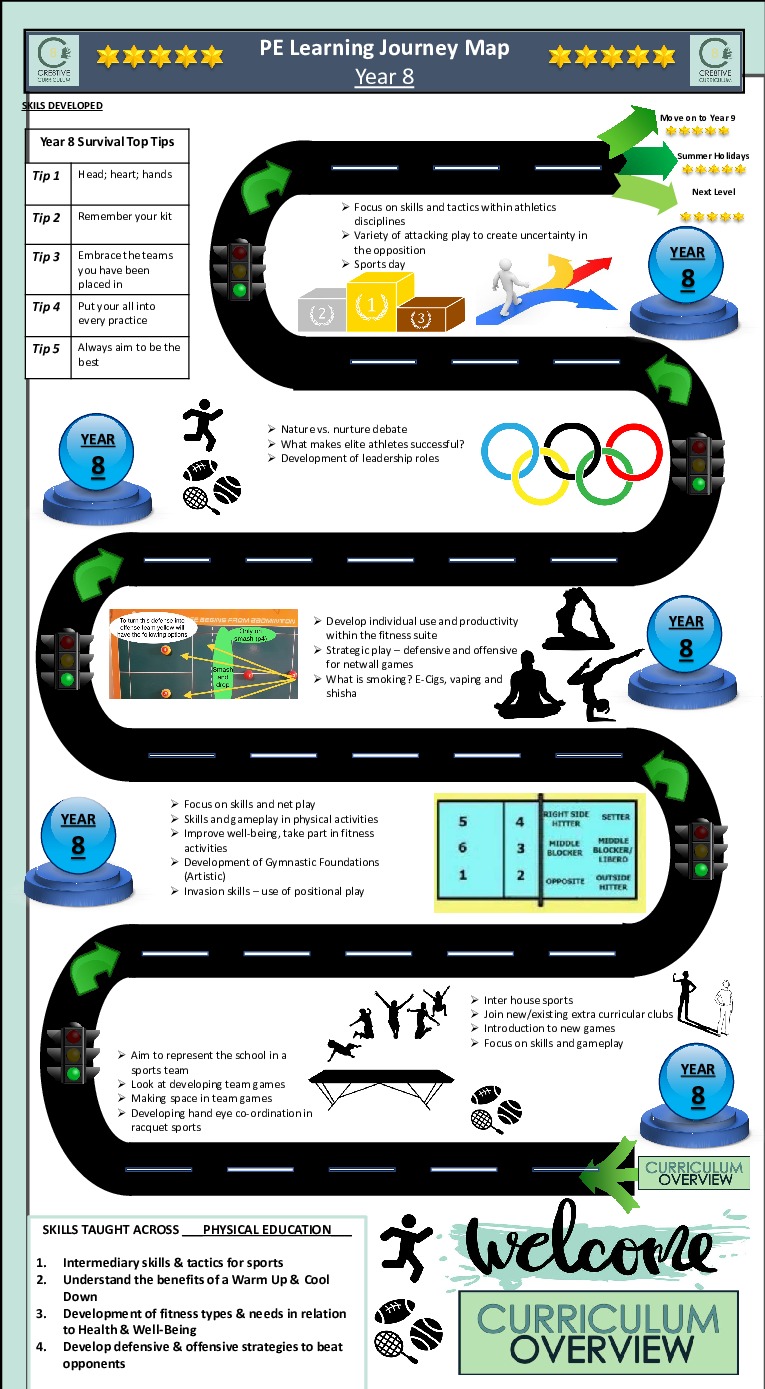
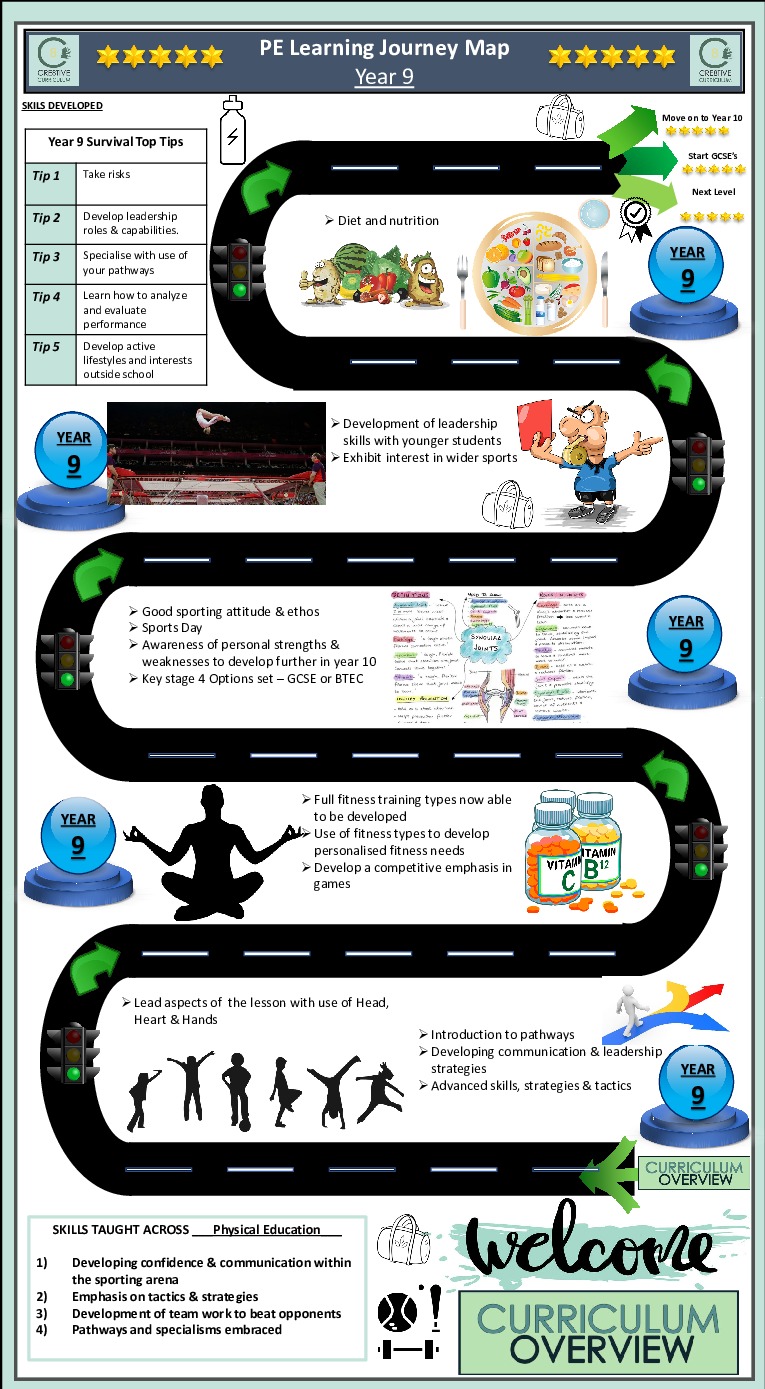
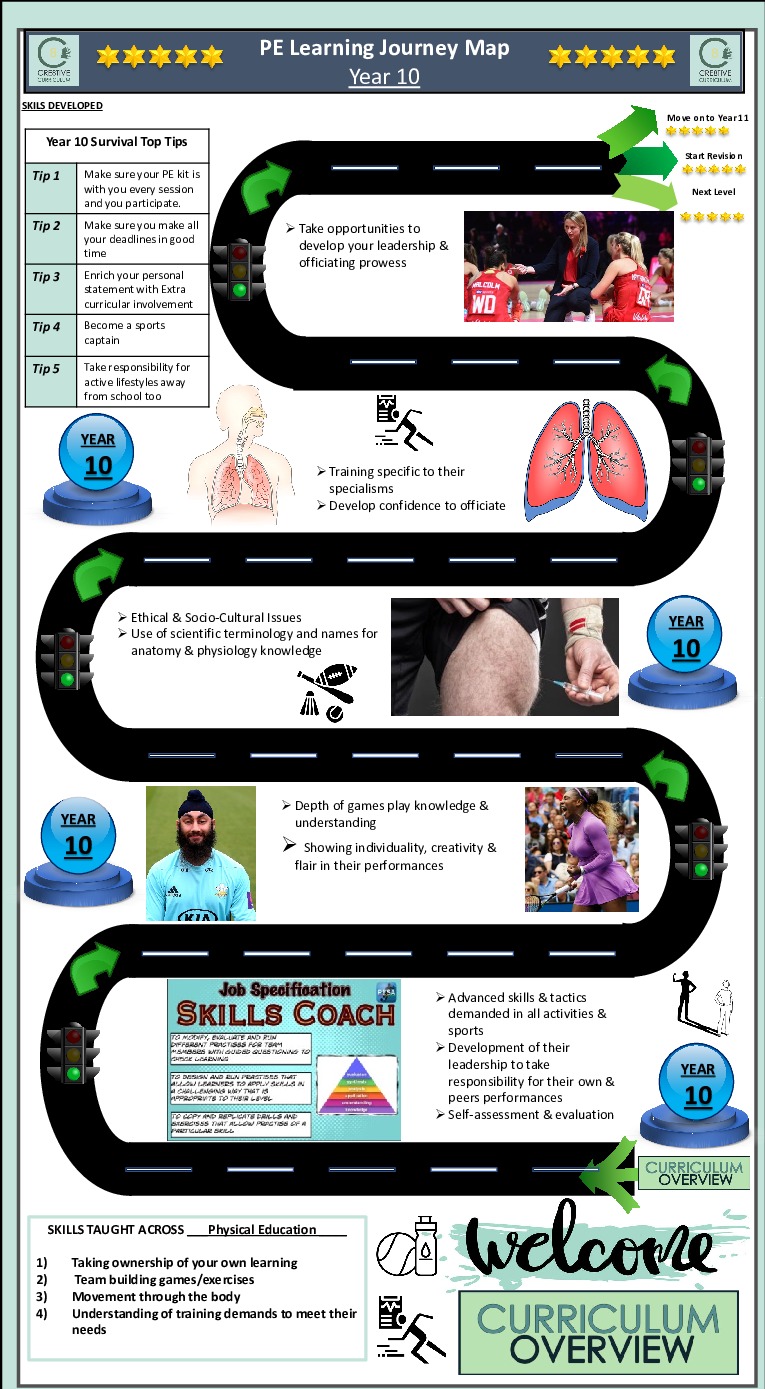
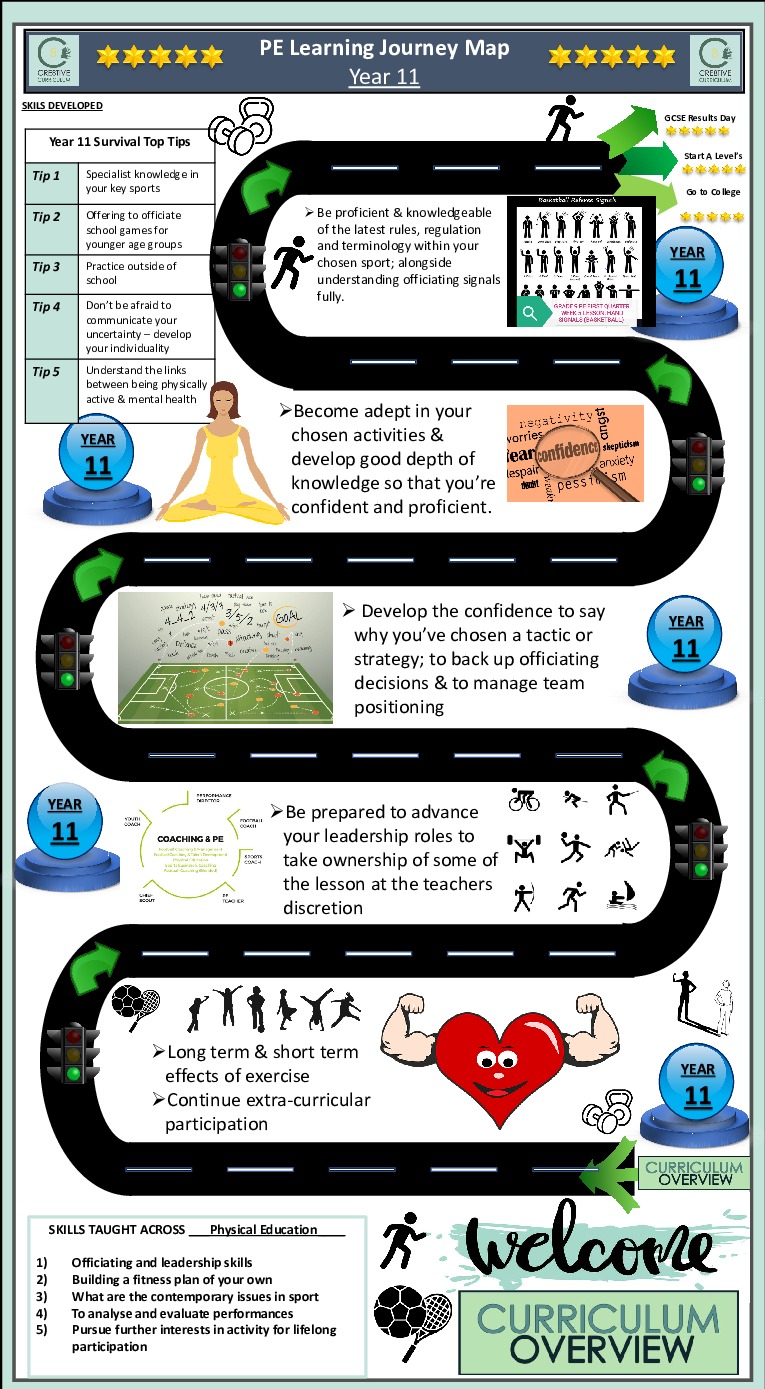
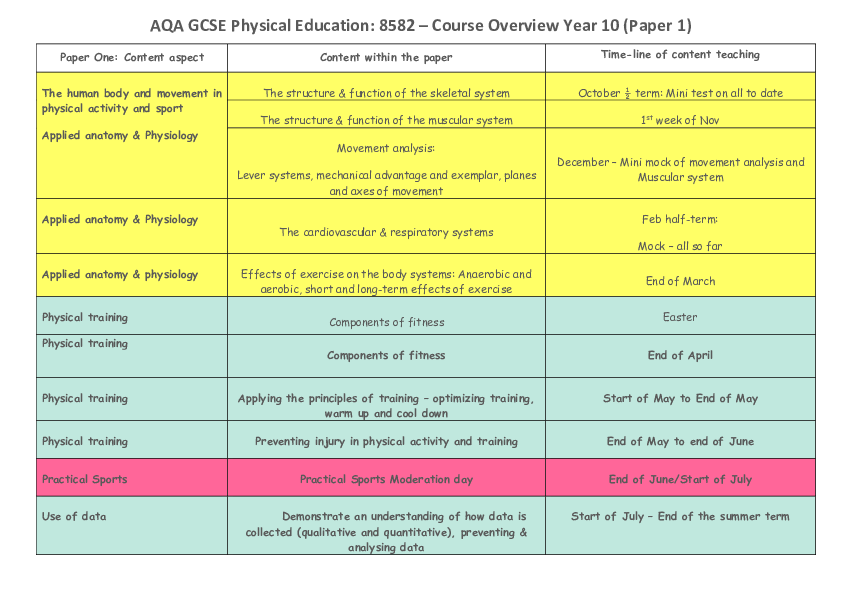
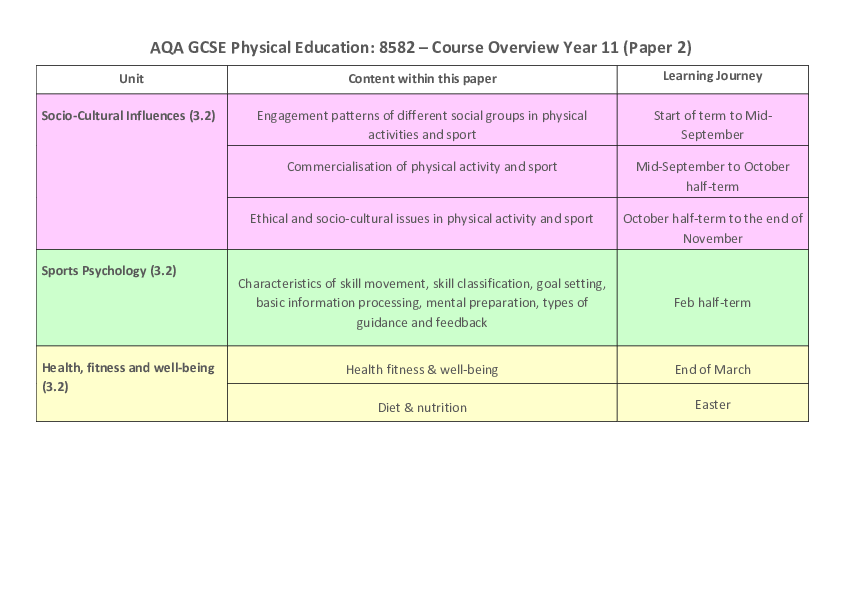
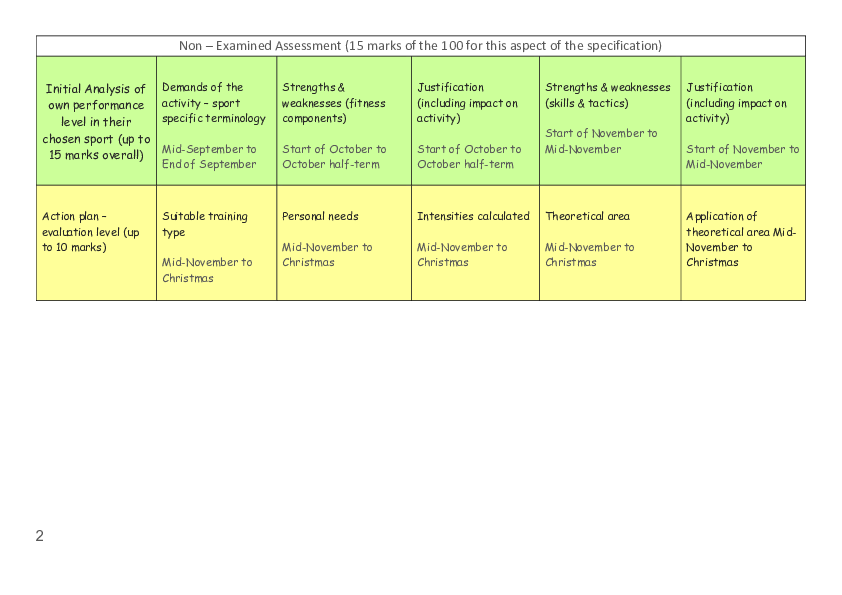
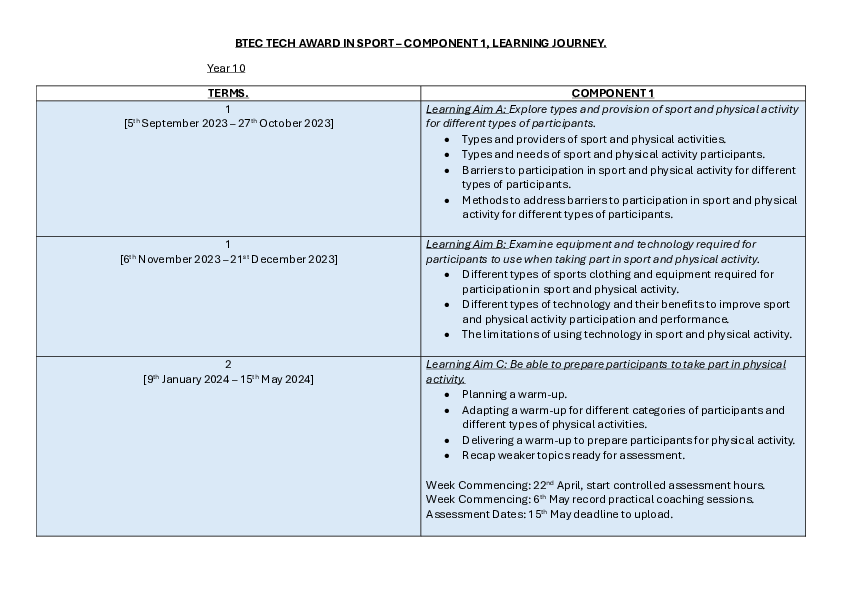
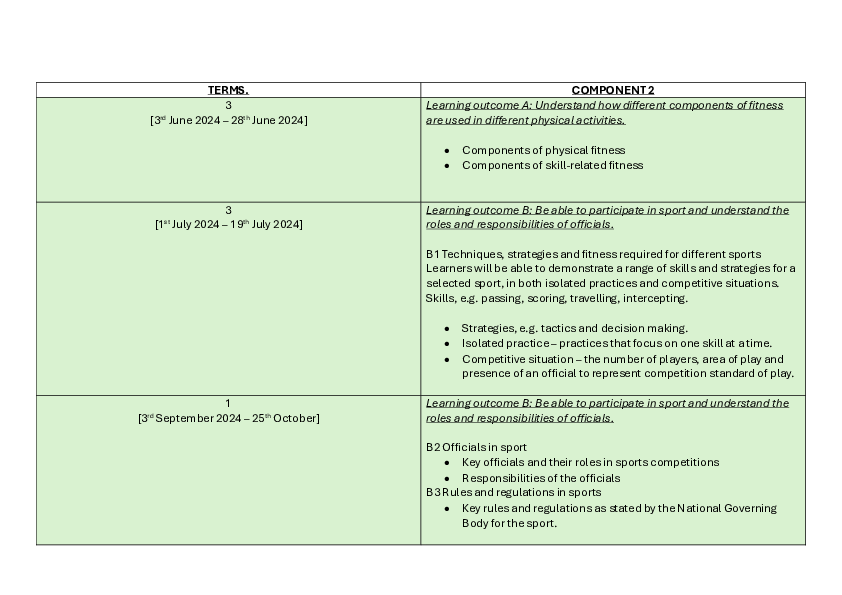

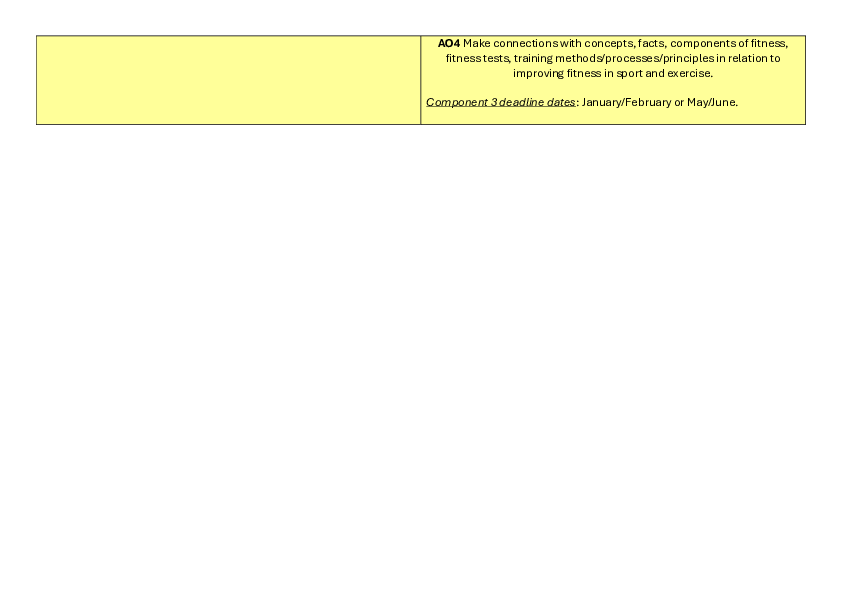
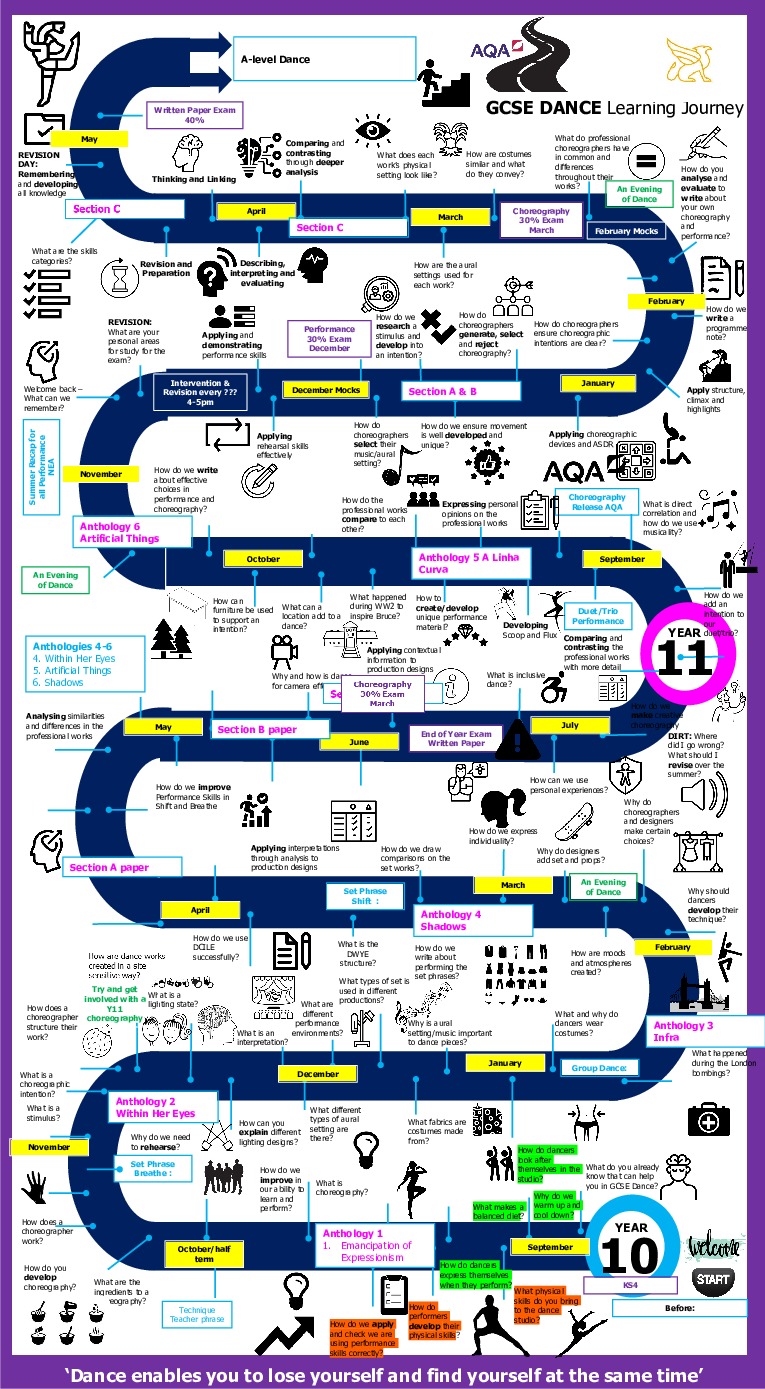
Core PE Curriculum Overview - Key Stage 3
| Year 7 | Term 1 | Term 2 | Term 3 |
|---|---|---|---|
| New Knowledge: |
Invasion Games – Rugby, Netball, Hockey, Football, Basketball
Net & Wall – Badminton
Fitness
Gymnastics
Dance
|
Invasion Games – Hockey, Basketball, Frisbee, Football
Net & Wall – Badminton
Fitness
Trampoline
|
Striking and Fielding Sports – Rounders/Cricket
Invasion Games – Frisbee
Net & Wall – Tennis
Athletics
|
| Previous Knowledge Required: |
Invasion Games – Rugby, Netball, Hockey, Football, Basketball Sending , Receiving , Marking, Moving with the ball, Scoring Net & Wall – Badminton Holding a racquet, basic grip, forehand/backhand shots (if participated in it at all) Fitness How to walk, run. Jog, hold their own body weight, balance Gymnastics Balances, Levels, Holding Bodyweight, Rolling, Jumping Dance Jump, Hop, Slide, Lean, Kick |
Invasion Games – Hockey, Basketball, Frisbee, Football Sending , Receiving , Marking, Moving with the ball, Scoring Net & Wall – Badminton Holding a racquet, basic grip, forehand/backhand shots (if participated in it at all) Fitness How to walk, run. Jog, hold their own body weight, balance
Trampolining
|
Striking and Fielding Sports – Rounders/Cricket
Invasion Games – Frisbee
Net & Wall – Tennis
Athletics Use of basic locomotor skills – Jumping, Running, Throwing, Jogging |
| New Skills: |
Invasion Games - Rugby, Netball, Hockey, Football, Basketball Different types of shooting, passing, dribbling, running, pivoting, blocking, tackling, intercepting. Regaining possession, turning, getting free, moving without the ball. Net & Wall – Badminton Foundational shots – forehand, forehand drive, backhand, basic flick and underarm serve. Footwork, re-setting & POMO, basic tactical play.
Fitness Basic foundational fitness – Health Related Fitness based components & different types of training that will help enhance those fitness areas i.e. Interval /continuous training, Circuit training. FITT Principles, Warm ups, Stretching, Bodyweight exercises
Gymnastics Basics of locomotion – movements, linking movements, artistic flair, originality & temperament.
Dance Dance and its relationship with different types of music/rhythms. Basics of dance style Street Dance Basics of dance style Lindy Hop Basic choreography skills How to analyse others and own performances. Basics of performing in front of others. |
Invasion Games – Hockey, Basketball, Frisbee, Football Different types of shooting, passing, dribbling, running, pivoting, blocking, tackling, intercepting. Regaining Possession, Turning , Getting Free Moving without the ball
Net & Wall – Badminton Foundational shots – forehand, forehand drive, backhand, basic flick and underarm serve. Footwork, re-setting & POMO, basic tactical play.
Fitness Basic foundational fitness – Health Related Fitness based components & different types of training that will help enhance those fitness areas i.e. Interval /continuous training, Circuit training. FITT Principles, Warm ups, Stretching, Bodyweight exercises
Trampoline Safety: How to get on/off, how to land safely, how to stop etc. Straight jump, Basic shape jumps: tuck, pike, straddle. Basic twists: ½ turn. Full turn. Seat landings: Basic seat landing, Seat landing ½ twist out, ½ twist into seat landing, Swivel hips. Front & Back landings (basic) |
Striking and Fielding Sports – Rounder’s/Cricket Basic underarm/over arm bowling – learning different methods of batting, long barrier, short barrier, under or overarm throws
Invasion Games – Frisbee Regaining Possession, Turning , Getting Free, Moving without the ball
Net & Wall – Tennis Forehand & backhand with double handed grip, development of one handed grip and use of power & tempo for disguise & movement of the opponent, basic volley & basic overarm serve
Athletics Sprint start, passing of the relay baton, correct stance or grip of Javelin, Discuss and Shotput, Teaching points of the long and high jump = basic stages of approach, flight & landing after learning of how to mark out their run up (part of the approach) |
| Links to the school curriculum: |
Aspiration – Valuing the challenge in the journey to achievement and recognising the importance of the work ethic – Recognising challenge in sport/PE but wanting to rise to the occasion
Resilience: Being accepting that progress isn’t linear, that there will be ups & downs but so long as you’re striving to move forwards and attain then you’re on the correct pathway to success. Kindness: To act with respect & care to those around you. To show fair play & be respectful of the rules & regulations of the activity being undertaken. To show good sporting conduct both within the competitive situations and the greater sporting/school community to peers, staff & opponents alike
• Discipline - Valuing determination, concentration and resilience. Understanding order and process – Becoming strong and resilient to failure and wanting to make progress across several sports/activities |
Aspiration – Valuing the challenge in the journey to achievement and recognising the importance of the work ethic – Recognising challenge in sport/PE but wanting to rise to the occasion
Resilience: Being accepting that progress isn’t linear, that there will be ups & downs but so long as you’re striving to move forwards and attain then you’re on the correct pathway to success. Kindness: To act with respect & care to those around you. To show fair play & be respectful of the rules & regulations of the activity being undertaken. To show good sporting conduct both within the competitive situations and the greater sporting/school community to peers, staff & opponents alike. |
Aspiration – Valuing the challenge in the journey to achievement and recognising the importance of the work ethic – Recognising challenge in sport/PE but wanting to rise to the occasion
Resilience: Being accepting that progress isn’t linear, that there will be ups & downs but so long as you’re striving to move forwards and attain then you’re on the correct pathway to success. Kindness: To act with respect & care to those around you. To show fair play & be respectful of the rules & regulations of the activity being undertaken. To show good sporting conduct both within the competitive situations and the greater sporting/school community to peers, staff & opponents alike. |
| Independent Activities: |
|
|
|
| Web links: | https://www.sportengland.org/guidance-and-support/national-governing-bodieshttps://www.uksport.gov.uk/sportshttps://thegma.org.uk/national-governing-bodies-sport-and-other-sporting-organisations | https://www.sportengland.org/guidance-and-support/national-governing-bodieshttps://www.uksport.gov.uk/sportshttps://thegma.org.uk/national-governing-bodies-sport-and-other-sporting-organisations | https://www.sportengland.org/guidance-and-support/national-governing-bodieshttps://www.uksport.gov.uk/sportshttps://thegma.org.uk/national-governing-bodies-sport-and-other-sporting-organisations |
| Year 8 | Term 1 | Term 2 | Term 3 |
|---|---|---|---|
| New Knowledge: |
Invasion Games – Rugby, Netball, Hockey, Football, Basketball
Net & Wall – Badminton
Fitness Development of greater awareness of different methods of training i.e. SAQ, Fartlek, Yoga & Pilates, and Games based training i.e. Dice Attack. Awareness of training zones & exercise intensities. Begin to plan own pathway through the fitness suite. Gymnastics Travel & balance: Individual, pair and group balances, Linking of locomotor skills with balances, movements on and off the apparatus, floor work. Dance Formations, Space, Action, Crew work, Control, Focus.Timing, Manipulation of movement, Jazz, Stomp or Charleston
|
Invasion Games – Rugby, Netball, Hockey, Football, Basketball
Net & Wall – Badminton
Fitness Development of greater awareness of different methods of training i.e. SAQ, Fartlek, Yoga & Pilates, and Games based training i.e. Dice Attack. Awareness of training zones & exercise intensities. Begin to plan own pathway through the fitness suite. Trampolining Development of the basic shapes into types of landing i.e. straddle into front landing, pike into back landing. Development of landings at own pace i.e. Swivel hips &/or Roller, Back landing ½ twist in or out, Cat Twist. Front landing ½ twist in or out, Half and full turntable. Developmental stages towards the front somersault i.e. Hands & knees to forward turnover. |
Striking and Fielding Sports – Rounder’s, Cricket
Invasion Games – Frisbee
Net & Wall – Tennis Progression of more advanced skills in terms of Volley (punch & drive), ground strokes (spin, slice), touch or power plays (drop shots, smash and lob), types of serve (slice, spin) Athletics Specific teaching points for Field & Track events – more advanced techniques in all field events, use of pace, tactical and strategic planning in track events. |
| Previous Knowledge Required: |
Invasion Games Rugby, Netball, Hockey, Football, Basketball Basic foundational skills in different types of Shooting, Passing, Close control, Running on & off the ball, Creating or closing down space, Maintaining or regaining possession, turnovers in play and immediate reaction to it. Net & Wall – Badminton Foundational shots – forehand, forehand drive, backhand, basic flick and underarm serve. Footwork, re-setting & POMO, basic tactical play. Fitness Basic foundational fitness – Health Related Fitness based components & different types of training that will help enhance those fitness areas i.e. Interval /continuous training, Circuit training. FITT Principles, Warm ups, Stretching, Bodyweight exercises Gymnastics Basics of locomotion – movements, linking movements, artistic flair, originality & temperament. Dance Dance and its relationship with different types of music/rhythms. Basics of dance style Street Dance Basics of dance style Lindy Hop Basic choreography skills How to analyse others and own performances. Basics of performing in front of others. |
Invasion Games Rugby, Netball, Hockey, Football, Basketball Basic foundational skills in different types of Shooting, Passing, Close control, Running on & off the ball, Creating or closing down space, Maintaining or regaining possession, turnovers in play and immediate reaction to it. Net & Wall – Badminton Foundational shots – forehand, forehand drive, backhand, basic flick and underarm serve. Footwork, re-setting & POMO, basic tactical play. Fitness Basic foundational fitness – Health Related Fitness based components & different types of training that will help enhance those fitness areas i.e. Interval /continuous training, Circuit training. FITT Principles, Warm ups, Stretching, Bodyweight exercises Trampolining Basic shapes, Basic twists, Basic landings, Linking landings, Rotation. |
Striking and Fielding Sports – Rounder’s + Cricket Basic underarm + over arm bowling – learning different methods of batting, long barrier + short barrier, under + overarm throws Invasion Games – Frisbee Basic foundational skills in different types of Passing, Running on & off the disc, Creating or closing down space, Maintaining or regaining possession, turnovers in play and immediate reaction to it. Net & Wall – Tennis Forehand & backhand with double handed grip, development of one handed grip and use of power & tempo for disguise & movement of the opponent, basic volley & basic overarm serve Athletics Sprint start, passing of the relay baton, correct stance/grip of Javelin, Discus, Shot put, Teaching points of the long/triple & high jump = basic stages of approach, flight & landing after learning of how to mark out their run up (part of the approach) |
| New Skills: |
Invasion Games Rugby, Netball, Hockey, Football, Basketball Different types of Shooting, Passing, dribbling, running, pivoting, blocking, tackling, intercepting Defending the goal, Assisting, Defending Space Positioning, Communicating Net & Wall – Badminton Types of shots - Serving , Low Back hand serve High serve, Drive serve, Flick serve, Shot selection, Smash shot, Net shot, Drop Shot, Overhead Clear Fitness Interval/continuous training? Circuit training, FITT Principles, Warm ups, Stretching, Bodyweight exercises, Safety regarding weight stations, 1 Rep Max, Zones of training Gymnastics Canon, Unison, Symmetrical, Mirrored, Controlled, Extension, Tension, Counter Balance, Counter Tension, Support Balance, Strength, Flexibility Dance Formations, Space, Action, Teamwork, Control, Focus, Timing, Manipulation of movement, Jazz, Stomp |
Invasion Games Rugby, Netball, Hockey, Football, Basketball Different types of Shooting, Passing, dribbling, running, pivoting, blocking, tackling, intercepting. Defending the goal, Assisting, Defending Space Positioning, Communicating
Net & Wall – Badminton Types of shots - Serving , Low Back hand serve High serve, Drive serve, Flick serve, Shot selection, Smash shot, Net shot, Drop Shot, Overhead Clear Fitness Development of greater awareness of different methods of training i.e. SAQ, Fartlek, Yoga & Pilates, and Games based training i.e. Dice Attack. Awareness of training zones & exercise intensities. Begin to plan own pathway through the fitness suite. Safety regarding weight stations, 1 Rep Max, Zones of training Trampolining Development of the basic shapes into types of landing i.e. straddle into front landing, pike into back landing. Development of landings at own pace i.e. Swivel hips &/or Roller, Back landing ½ twist in or out, Cat Twist. Front landing ½ twist in or out, Half and full turntable. Developmental stages towards the front somersault i.e. Hands & knees to forward turnover.
|
Striking and Fielding Sports – Rounder’s + Cricket Different types of underarm/over arm bowling – learning different methods of batting, long barrier, short barrier, under + overarm throws Invasion Games – Frisbee Passing – Forehand, backhand, hammer throws Regaining Possession, Turning , Getting Free, Moving without the ball Net & Wall – Tennis Smash, forehand, backhand, flat, side spin, block, slice, topspin shot Athletics Specific teaching points for Field & Track events – more advanced techniques in all field events, use of pace, tactical and strategic planning in track events. |
| Links to the school curriculum: |
Aspiration – Valuing the challenge in the journey to achievement and recognising the importance of the work ethic – Recognising challenge in sport/PE but wanting to rise to the occasion
Resilience: Being accepting that progress isn’t linear, that there will be ups & downs but so long as you’re striving to move forwards and attain then you’re on the correct pathway to success. Kindness: To act with respect & care to those around you. To show fair play & be respectful of the rules & regulations of the activity being undertaken. To show good sporting conduct both within the competitive situations and the greater sporting/school community to peers, staff & opponents alike. |
Aspiration – Valuing the challenge in the journey to achievement and recognising the importance of the work ethic – Recognising challenge in sport/PE but wanting to rise to the occasion
Resilience: Being accepting that progress isn’t linear, that there will be ups & downs but so long as you’re striving to move forwards and attain then you’re on the correct pathway to success. Kindness: To act with respect & care to those around you. To show fair play & be respectful of the rules & regulations of the activity being undertaken. To show good sporting conduct both within the competitive situations and the greater sporting/school community to peers, staff & opponents alike. |
Aspiration – Valuing the challenge in the journey to achievement and recognising the importance of the work ethic – Recognising challenge in sport/PE but wanting to rise to the occasion
Resilience: Being accepting that progress isn’t linear, that there will be ups & downs but so long as you’re striving to move forwards and attain then you’re on the correct pathway to success. Kindness: To act with respect & care to those around you. To show fair play & be respectful of the rules & regulations of the activity being undertaken. To show good sporting conduct both within the competitive situations and the greater sporting/school community to peers, staff & opponents alike. |
| Independent Activities: |
|
|
|
| Web Links: | https://www.sportengland.org/guidance-and-support/national-governing-bodieshttps://www.uksport.gov.uk/sportshttps://thegma.org.uk/national-governing-bodies-sport-and-other-sporting-organisations | https://www.sportengland.org/guidance-and-support/national-governing-bodieshttps://www.uksport.gov.uk/sportshttps://thegma.org.uk/national-governing-bodies-sport-and-other-sporting-organisations | https://www.sportengland.org/guidance-and-support/national-governing-bodieshttps://www.uksport.gov.uk/sportshttps://thegma.org.uk/national-governing-bodies-sport-and-other-sporting-organisations |
Intermediary level: Year 9 & Year 10.
Students are split into one of three separate pathways & then will complete blocks of activity within each over the course of the year. Blocks will last for 6 weeks. They will be completed in an order that suits the facilities, staffing & students’ best.
| Year 9 | Aesthetics pathway | Traditional games pathway | All-rounder pathway (Spice) |
|---|---|---|---|
| Activity Type: | Badminton | Football | Trampolining |
| New Knowledge: |
Selection of appropriate shot Awareness of the rules and regulations of the sport and their application Principals of attack and defence e.g. roles and positioning |
Decision making & tactical awareness: When/where to pass, shoot, dribble, tackle Which pass Defensive plays |
Combined movements Sequence’s accuracy as well as its conformity to regulations • Height Consistency: Continuity/flow of the sequence Control, to include: • Success in both the individual elements and the sequence as a whole; • Centring; • Phasing. • Maintenance of height and body position Awareness of the rules and regulations of the activity and their application (including judging signals) |
| Previous knowledge: |
Advanced rules of sport Development of combination skills to move opponents around i.e. Overhead clear & drop shot. Power & touch – use as key to gain an attacking advantage Defensive play for time and return to POMO |
Advanced Rules of sports/code of conduct – Refer to national governing bodies Development of attacking use of space, Movement, Scoring & Penetration, Support, Communication – development from small 1v1, 2v2 games to small-sided games of 3v3 to 5v5 or more. Defensive Individual pressure & approach/body angle & position, contest at turnovers, support from team mates into a team press or pressure, Communication – signals, body language etc. |
Development of the basic shapes into types of landing i.e. straddle into front landing, pike into back landing. Development of landings at own pace i.e. Swivel hips &/or Roller, Back landing ½ twist in or out, Cat Twist. Front landing ½ twist in or out, Half and full turntable. Developmental stages towards the front somersault i.e. Hands & knees to forward turnover. |
| Previous Knowledge: |
Advanced rules of sport Development of combination skills to move opponents around i.e. Overhead clear & drop shot. Power & touch – use as key to gain an attacking advantage Defensive play for time and return to POMO |
Advanced Rules of sports/code of conduct – Refer to national governing bodies Development of attacking use of space, Movement, Scoring & Penetration, Support, Communication – development from small 1v1, 2v2 games to small-sided games of 3v3 to 5v5 or more. Defensive Individual pressure & approach/body angle & position, contest at turnovers, support from team mates into a team press or pressure, Communication – signals, body language etc. |
Development of the basic shapes into types of landing i.e. straddle into front landing, pike into back landing. Development of landings at own pace i.e. Swivel hips &/or Roller, Back landing ½ twist in or out, Cat Twist. Front landing ½ twist in or out, Half and full turntable. Developmental stages towards the front somersault i.e. Hands & knees to forward turnover. |
| New Skills/ Tactics |
Lift/underarm clear Drive Net shots Backhand shots: • Overhead clear • Drop shot • Lift/underarm clear • Smash • Drive |
Player to player, zonal defence and/or attack |
Swivel hips • Half/full twist in/out of front and back landing • Seat to front • Front to seat Back to front • Front to back Half & full turntable |
| Links to the school curriculum: |
Aspiration – Valuing the challenge in the journey to achievement and recognising the importance of the work ethic – Recognising challenge in sport/PE but wanting to rise to the occasion Resilience: Being accepting that progress isn’t linear, that there will be ups & downs but so long as you’re striving to move forwards and attain then you’re on the correct pathway to success. Kindness: To act with respect & care to those around you. To show fair play & be respectful of the rules & regulations of the activity being undertaken. To show good sporting conduct both within the competitive situations and the greater sporting/school community to peers, staff & opponents alike |
Aspiration – Valuing the challenge in the journey to achievement and recognising the importance of the work ethic – Recognising challenge in sport/PE but wanting to rise to the occasion Resilience: Being accepting that progress isn’t linear, that there will be ups & downs but so long as you’re striving to move forwards and attain then you’re on the correct pathway to success. Kindness: To act with respect & care to those around you. To show fair play & be respectful of the rules & regulations of the activity being undertaken. To show good sporting conduct both within the competitive situations and the greater sporting/school community to peers, staff & opponents alike. |
Aspiration – Valuing the challenge in the journey to achievement and recognising the importance of the work ethic – Recognising challenge in sport/PE but wanting to rise to the occasion
Resilience: Being accepting that progress isn’t linear, that there will be ups & downs but so long as you’re striving to move forwards and attain then you’re on the correct pathway to success. Kindness: To act with respect & care to those around you. To show fair play & be respectful of the rules & regulations of the activity being undertaken. To show good sporting conduct both within the competitive situations and the greater sporting + school community to peers, staff & opponents alike. |
| Independent Activities: |
|
|
|
| Weblinks: | https://www.sportengland.org/guidance-and-support/national-governing-bodieshttps://www.uksport.gov.uk/sportshttps://thegma.org.uk/national-governing-bodies-sport-and-other-sporting-organisations | https://www.sportengland.org/guidance-and-support/national-governing-bodieshttps://www.uksport.gov.uk/sportshttps://thegma.org.uk/national-governing-bodies-sport-and-other-sporting-organisations | https://www.sportengland.org/guidance-and-support/national-governing-bodieshttps://www.uksport.gov.uk/sportshttps://thegma.org.uk/national-governing-bodies-sport-and-other-sporting-organisations |
| Year 9 | Aesthetics pathway | Traditional games pathway | All-rounder pathway (Spice) |
|---|---|---|---|
| Activity Type: | Gymnastics | Hockey | Basketball |
| New Knowledge: |
Theme - flight: Basic vaulting |
Advanced skills, (all outfield positions) – Strategy, tactics & positioning and spatial awareness is the focus. Core skills, (goalkeeper) When to pass, tackle, shoot, switch stick hands • Where to pass, tackle, shoot • Which pass to make |
When to run, pass, shoot, dribble • Where to run, pass, shoot, dribble • Which pass to make Shooting, Re-bounding, Beating individuals |
| Previous Knowledge: |
Olympic gymnastics : Take off, flight & landing Rolls – forward and backward variations: • to straddle • dive forward Balances using different parts of the body Cartwheels Round offs Jumps + leaps, Twists + pivots Steps Tumbling lines Dance elements Transitions Low tariff release + dismounts off equipment |
|
Stance and footwork: • Triple threat position • Pivoting Passing: • Chest • Bounce • Javelin/overhead Shooting: • Set shot • Jump shot • Dominant hand lay-up Dribbling: • Use of dominant hand Marking: • Player with the ball |
| New skills and tactics | Squat and Straddle • Handspring • Long arm • Run up • Use of spring board/trampettes • dismount |
Reverse stick passing: • Push • Drive • Hit • Slap • Scoop Open or reverse passing: • Flick Open passing: • Aerial scoop Receiving and stopping the ball whilst on the move: • Grip and body position • Using Reverse stick Dribbling: • Ability to beat opponents • Indian dribble • Close control • Tackling • Shave Marking: • Player without the ball/shadowing GK: Receiving and stopping the ball whilst stationary. Shot stopping: • Saving shots • Positioning • Narrowing the angles • Use of pads/feet and stick • Interceptions (front and reverse stick) • Clearances |
• Non-dominant hand Lay-up • Hook shot Fake and drive • Cross over step |
| Year 9 | Aesthetics Pathway | Traditional Games Pathway | All rounder pathway (spice) |
|---|---|---|---|
| Activity Type: | Fitness | Badminton | Gymnastics |
| New Knowledge: |
Development of control of pulse rate when exercising and varying intensities for the type of fitness training that you’re developing Beginning to use training types that they may use outside of school too |
Selection of appropriate shot Awareness of the rules and regulations of the sport and their application Principals of attack and defence e.g. roles and positioning |
Basic Vaulting |
| Previous Knowledge: | Basic foundations of fitness – what the main building blocks are, differences between anaerobic and aerobic exercise; pulse rate and intensity of exercise for whether it’s aerobic or anaerobic |
Advanced rules of sport Development of combination skills to move opponents around i.e. Overhead clear & drop shot. Power & touch – use as key to gain an attacking advantage Defensive play for time and return to POMO |
Olympic gymnastics : Take off, flight & landing Rolls – forward and backward variations: • to straddle • dive forward Balances using different parts of the body Cartwheels Round offs Jumps, leaps Twists, pivots Steps Tumbling lines Dance elements Transitions Low tariff release + dismounts off equipment |
| New skills/tactics |
Types of training and use of pulse monitors to determine exercise intensities: Speed training Circuits Legs. Bums n tums Interval training Fartlek training Coordination & flexibility training Yoga and Pilates Cross training |
Lift/underarm clear Drive Net shots Backhand shots: • Overhead clear • Drop shot • Lift/underarm clear • Smash • Drive |
Squat and Straddle • Handspring • Long arm • Run up • Use of spring board/trampettes • dismount |
| Year 9 | Aesthetics pathway | Traditional games pathway | All-rounder pathway (Spice) |
|---|---|---|---|
| Activity Type: | Trampolining | Netball | Rugby Union |
| New Knowledge: |
Combined movements Sequence’s accuracy as well as its conformity to regulations • Height Consistency: • Continuity + flow of the sequence Control, to include: • Success in both the individual elements and the sequence as a whole; • Centring; • Phasing. • Maintenance of height and body position Awareness of the rules and regulations of the activity and their application (including judging signals) |
Advanced skills, (applies to all positions) When to pass, shoot + dodge Where to pass+shoot+dodge Which pass to make |
Advanced passing, beating an opponent, contact, tackling When to run, pass + kick • Where to run, pass + kick • Which pass to make • Controlled phase possession • Collective alignment • Methods to cross the gain line |
| Previous Knowledge: | Core skills = Shapes, twists, seat landings, rotational movements | Footwork: • Stopping/landing • Pivoting Dodging Ball handling: • Catching whilst stationary Passing over short distances: • Chest • Overhead • Bounce • Shoulder pass Shooting: (GS and GA only) • Stationary Rebounds (GA, GS, GD, GK only) Marking: • Player with the ball | Core skills – Handling & carrying, passing, balanced running, beating opponents, try scoring, tackling, basic ruck & maul |
| New Skills/Tactics |
Swivel hips • Half + full twist in + out of front and back landing • Seat to front • Front to seat Back to front • Front to back Half & full turntable |
Ball handling: • Catching on the run • Catching in the air Passing over mid-long distance: • Chest • Overhead • Bounce • Shoulder pass Shooting: (GS and GA only) • Stepping Defence: • Shadowing • Interception • Marking player without the ball |
Handling and carrying skills: Passing: • Spin, both ways Beating opponents: • Feint • Swerve • Dummying • Switching Contact skills: • Jackal • Counter ruck Tackling: • Basic technique from rear, smothering |
| Year 9 | Aesthetics Pathway | Traditional Games Pathway | All-Rounder Pathway |
|---|---|---|---|
| Activity Type: | Dance | Volleyball | Trampolining |
| New Knowledge: |
Core skills measured through the movement phases identified in posture and placement, alignment, and tension, use of space, level & flight. Movement skills should be completed with varying speeds, energy, rhythm, flair & originality. Specific dance movement skills based on the discipline i.e. Ballet (Pirouettes, Leaps & Balances), Ballroom (Turns and spins, Chasse, Walks), Contemporary (Leaps, Balances, Turns & travelling, step patterns), Street (Jumps, holds and grabs, step patterns, turn & travelling). |
Selection of appropriate shot • Understanding of positions and roles in attack and defence • Awareness of the rules and regulations of the sport and their application |
Combined movements Sequence’s accuracy as well as its conformity to regulations • Height Consistency: • Continuity and flow of the sequence Control, to include: • Success in both the individual elements and the sequence as a whole; • Centring; • Phasing. • Maintenance of height and body position Awareness of the rules and regulations of the activity and their application (including judging signals) |
| Previous Knowledge: | Posture/placement • Alignment • Tension • Use of space, levels and flight | None | Core skills = Shapes, twists, seat landings, rotational movements |
| New Skills and Tactics |
Street: Jumps • Holds and grabs • Step patterns • Turns and travelling Contemporary: Leaps • Balances • Turns and travelling • Step patterns Movement skills completed with varying: • Speed • Energy • Rhythm • Flair • Originality |
Serving: • Tennis Overhead techniques: • Volley • Setting Underhand techniques: • Dig • Receiving service Teamwork and communication |
Swivel hips • Half/full twist in/out of front and back landing • Seat to front • Front to seat Back to front • Front to back Half & full turntable |
| Year 9 | Aesthetics Pathway | Traditional Games Pathway | All-rounder Pathway |
|---|---|---|---|
| Activity Type: | Rounders | Athletics | Frisbee |
| New Knowledge: |
Development of advanced skills:
|
|
Intermediate backhand and forehand Running bases Game development through 4 v 4 mini games |
| Previous Knowledge: |
Basic batting, fielding skills Application of correct rules and regulations based on the NRA guidelines |
Track & field core skills Awareness of the rules and regulations of the event and their application (including officials commands/signals) |
Teaching of self-officiating Spirit of the game Application & awareness of the rules Pancake catch, basic backhand 3 on 3 mini games Lobster catch, basic forehand |
| New Skills and Tactics |
|
Travel: • use of cross step/glide (where applicable) • rotational throws Leg action – foot strike, cadence |
Intermediate backhand & forehand Running bases 4 on 4 mini games
|
| Year 9 | Aesthetics Pathway | Traditional Games Pathway | All-rounder Pathway |
|---|---|---|---|
| Activity Type: | Tennis | Cricket | Rounders |
| New Knowledge: |
Awareness of the rules and regulations of the sport and their application Principals of attack and defence e.g. roles and positioning • Understanding of positions and roles in attack and defence |
Batting, bowling, fielding & wicket keeping – advanced skills |
Development of advanced skills:
|
| Previous Knowledge: |
Serving Return of serve Groundstrokes: • Forehand • Backhand Volleys: • Forehand • Backhand Selection of appropriate shot |
Batting, bowling, fielding & wicket keeping – core skills Awareness of the rules and regulations of the sport and their application Selection of appropriate shot |
Basic batting, fielding skills Application of correct rules and regulations based on the NRA guidelines |
| New Skills and Tactics |
Forehand lob Court positioning: • Footwork • Speed • Mobility Advanced skills, to include: (both singles and doubles unless stated) Groundstrokes: – variety of spin (backspin/ slice and topspin) • Forehand • Backhand |
Batting: • Defensive shots off back foot • Square cut • Hook shots • Off or on drive • Sweep Bowling: • Variation in delivery in terms of line, flight, speed and length of bowl Fielding: (outfield, infield and close) • Pick up and throw for a run out – underarm and overarm • Pick up and throw on the run Wicket Keeping: • Leg side takes and catches • Stumping |
Batting - backhand, angles Types of bowls– back spin, spin, donkey drop, different heights, speeds, trajectories etc. Basic Tactics – bowler, back, first; Bowler, back, 2nd |
Core PE Curriculum Overview - Key Stage 4
Year 10: Core PE - Pathways continue as last year - movement of student in very few instances if previous pathway not suited or movement to appropriate pathway if new halfway through year 9. Blocks of 6 week rotations but again the order will vary as per the situations mentioned previous.
| Games 1 | Games 2 | Spice 1 | Spice 2 | Aesthetics | |
|---|---|---|---|---|---|
| 4th Sept | Football | Hockey | Badminton | Netball | Trampo/Gym |
| 6th Nov | Rugby | Netball | Fitness | Badminton | Dance |
Year 10 Trackpoint 1: 20th Nov - 24th Nov
| Games 1 | Games 2 | Spice 1 | Spice 2 | Aesthetics | |
|---|---|---|---|---|---|
| 9th Jan | Fitness | Badminton | Football | Trampo/Gym | Netball |
| 19th Feb | Badminton | Fitness | Rugby | Hockey | Volleyball |
Year 10 Trackpoint 2: 24th Feb - 1st Mar
| Games 1 | Games 2 | Spice 1 | Spice 2 | Aesthetics | |
|---|---|---|---|---|---|
| 8th Apr | Tennis | Athletics | Cricket | Rounders | Frisbee |
Year 10 Trackpoint 3: 29th Apr - 3rd May
| Games 1 | Games 2 | Spice 1 | Spice 2 | Aesthetics | |
|---|---|---|---|---|---|
| 8th Apr | Athletics | Rounders | Tennis | Cricket and Frisbee | Athletics and Rounders |
Activity blocks for each pathway will follow the timetable shown above but will cover the same activity curriculum as shown in the overview below.
Year 10
| Activity Type: | Football: | Badminton: | Trampolining |
|---|---|---|---|
| New Knowledge: |
Awareness of team strategies and tactics in both attacking and defending situations |
Understanding of positions and roles in attack and defence Applying different systems and formations of play in different situations e.g. attacking and defensive formations in doubles |
Difficulty of routine, balance of difficulty with quality of execution • Composition of routine • Flow of routine • Order of the skills in routine • Body awareness • Use of flight • Acceleration/deceleration of movements • Spatial awareness • Use of showmanship • Awareness of strengths and weaknesses and actions of other performers e.g. adopt a different routine and tariff of discipline depending on score achieved by other competitors |
| Previous Knowledge: |
Serving Return of serve Groundstrokes: • Forehand • Backhand Volleys: • Forehand • Backhand Selection of appropriate shot |
Selection of appropriate shot Awareness of the rules and regulations of the sport and their application Principals of attack and defence e.g. roles and positioning
|
Awareness of the rules and regulations of the activity and their application (including judging signals) Combined movements Sequence’s accuracy as well as its conformity to regulations • Height |
| New Skills and Tactics |
Set piece plays, corners • Attacking positioning on the field • Defensive positioning on the field |
Attacking & defensive formations – doubles Tactics in different competitive situations (doubles) |
Cradle • Front somersault (tucked) • Back somersault (tucked) |
| Activity Type: | Netball: | Hockey: | Gymnastics |
|---|---|---|---|
| New Knowledge: |
Awareness of strengths and weaknesses and actions of other players • Awareness of the rules and regulations of the game and their application |
Advanced skills, (goalkeeper) Awareness of team strategies/tactics in both attacking and defending situations • Attacking positioning on the field • Defensive positioning on the field • Defensive ploys |
Difficulty of routine, balance of difficulty with quality of execution • Composition of routine • Flow of routine • Order of the skills in routine • Body awareness • Use of flight • Acceleration/deceleration of movements • Spatial awareness • Use of showmanship • Awareness of strengths and weaknesses and actions of other performers e.g. adopt a different routine and tariff of discipline depending on score achieved by other competitors |
| Previous Knowledge: |
When to pass, shoot, dribble, tackle • Where to pass, shoot, dribble, tackle • Which pass to make |
Selection of appropriate shot Awareness of the rules and regulations of the sport and their application Principals of attack and defence e.g. roles and positioning |
Basic locomotion Basic travel & linking of moves Linking of locomotion & travel to design sequences & routines Basic Vaulting Combine all the over to generate a performance at the end of key stage 3 |
| New Skills and Tactics |
Advanced skills, (applies to all positions) When to pass, shoot, dodge • Where to pass, shoot, dodge • Which pass to make |
Advanced skills, (all outfield positions) Core skills, (goalkeeper) |
Advanced rolls – roll to handstands Hand/head springs Somersaults Saltos – forwards/backwards Walkover |
| Activity Type: | Rugby Union | Fitness | Dance |
|---|---|---|---|
| New Knowledge: |
Specialist skills Awareness of strengths/weaknesses and actions of other players e.g. adopt a variety of roles in attack and defence in the game • Awareness of the rules and regulations of the game and their application (including refereeing signals) |
Sport specific and components of fitness specific fitness tests. Development of personalised programmes with the teacher to develop a programme suited to the needs of that key group. Groups to be:
Combi fitness i.e. footballers, hockey players, Netballers, Rugby players, Basketballers |
Technique of manoeuvres completed with high levels of aesthetics of movements, balance, control of body shape and expression. Choreography of routines for motifs, theme & variation, repetition and climax. |
| Previous Knowledge: |
Advanced passing, beating an opponent, contact, tackling |
Development of control of pulse rate when exercising and varying intensities for the type of fitness training that you’re developing Beginning to use training types that they may use outside of school too |
Core skills measured through the movement phases identified in posture and placement, alignment, and tension, use of space, level & flight. Movement skills should be completed with varying speeds, energy, rhythm, flair & originality. Specific dance movement skills based on the discipline i.e. Ballet (Pirouettes, Leaps & Balances), Ballroom (Turns/spins, Chasse, Walks), Contemporary (Leaps, Balances, Turns & travelling, step patterns), Street (Jumps, holds/grabs, step patterns, turn & travelling). |
| New Skills and Tactics |
Scrum – individual positions and roles, collective skills of pushing and holding, ball distribution, support play once ball is out • Set scrimmaging – binding, position of feet; angle of drive for each row Line out play – tactics, roles and support |
Programmes that are specific to their needs using the fitness suite, main hall and gym for different types of training and classes ie. Boxercise, yoga, skills circuits |
Technique of manoeuvres completed with high levels of: • Aesthetics of movements – body tension/ extension, coordination of body parts • Balance • Control of body shape • Expression Choreography of routines: • Motifs • Theme and variation • Repetition • Climax |
| Activity Type: | Volleyball | Tennis | Athletics |
|---|---|---|---|
| New Knowledge: |
Principles of attack and defence |
Applying tactics in different competitive situations • Applying different systems and formations of play in different situations |
Track: Pre-race tactics • Changing and adapting your race tactics • Positioning in the field, where to run in the pack, when to lead and when to follow (where appropriate) • Timing of kicking for the finish line • When to dip for the finish line • Awareness of the rules and regulations of the event and their application (including officials commands and signals) Field: Pre-event tactics • Tactics for qualifying throws • Changing and adapting your throwing tactics: • Consideration of weather conditions • Check mark adjustments (javelin only) • Awareness of the rules and regulations of the event and their application (including officials commands and signals) |
| Previous Knowledge: |
Awareness of the rules and regulations of the sport and their application Selection of appropriate shot • Understanding of positions and roles in attack and defence |
Awareness of the rules and regulations of the sport and their application Principals of attack and defence e.g. roles and positioning • Understanding of positions and roles in attack and defence |
Approach – flight – landing - jumps |
| New Skills and Tactics |
Serving: • Float Return of serve Overhead techniques: • Spike Underhand techniques: • Rebounding Teamwork and communication |
Doubles – attacking & defensive formations |
Track: • Starting: • Use of blocks (where relevant) • Leg action: • Foot strike • Cadence • Bend running (where relevant) • Stride pattern/pacing • Hurdling with either leg (where relevant) Field: Throws - • Travel: • use of cross step and glide (where applicable) • rotational throws (where applicable) • Release phase: • Appropriate angle of release • Efficient transition between technical phases of the movements Jumps - Approach: hitting appropriate speed for take-off • Efficient transition between technical phases of the movements • Flight: • Appropriate elevation • Landing • movement of the body beyond initial point of contact (long jump and triple jump) |
| Activity Type: | Cricket | Rounders | Frisbee |
|---|---|---|---|
| New Knowledge: |
Understanding and use of positions and roles in batting and fielding • Principles of attack and defence • Applying different systems of play in different situations e.g. switching bowling styles to keep the opposition guessing • Effective decision making for running between wickets Awareness and application of team strategies and tactics |
Advanced fielding skills Advanced fielding tactics Advanced batting tactics Development of game plans and strategies |
Advanced throws Releasing the disc at various heights (decision making) Mini games to promote tactical and strategic awareness |
| Previous Knowledge: |
Batting, bowling, fielding & wicket keeping – advanced skills |
Development of advanced skills:
Basic tactics for fielding |
|
| New Skills and Tactics |
Decision making & tactical awareness |
Fielding skills – cup pass, double tap out, relay fielding Fielding tactics – double tap, Fielder, 2nd, 4th; fielder, bowler; fielder, 4th, batting square etc. Batting tactics – hitting order, hitting directions dependent upon fielding, no-ball tactics etc. Strategic & tactical game plan through batting order, fielding positions, whom to get out etc. |
Hammer throw – outside in & inside out 5 on 5s Types of defence – zone, player on player Marking & reading the disc Fakes & cuts Throws - • Travel: • use of cross step and glide (where applicable) • rotational throws (where applicable) • Release phase: • Appropriate angle of release • Efficient transition between technical phases of the movements Jumps - Approach: hitting appropriate speed for take-off • Efficient transition between technical phases of the movements • Flight: • Appropriate elevation • Landing • movement of the body beyond initial point of contact (long jump and triple jump) |
Now that the students are very much individuals and have determined their preferred pathway, &, within that, their preferred sports we want to give them ownership of their activities as they would have when they leave school. Consequently, we allow the students to determine their chosen sport/activity with the most commonly picked being available that equates to the number of staff and facilities.
Below are the curriculum overviews for the sport or activity – should they chose it. The activity blocks are half-termly; at the end of that time the students opt again. They can choose to stay with the same activity or opt for a different one – just like they would away from school. There are competitive matches outside of curriculum time for year 11 & within or without curriculum time for the 6th formers dependent upon the activity being undertaken.
| Activity Type: | Football: | Badminton: | Trampolining |
|---|---|---|---|
| New Knowledge: |
Awareness of team strategies and tactics in both attacking and defending situations |
Understanding of positions and roles in attack and defence Applying different systems and formations of play in different situations e.g. attacking and defensive formations in doubles |
Difficulty of routine, balance of difficulty with quality of execution • Composition of routine • Flow of routine • Order of the skills in routine • Body awareness • Use of flight • Acceleration/deceleration of movements • Spatial awareness • Use of showmanship • Awareness of strengths and weaknesses and actions of other performers e.g. adopt a different routine and tariff of discipline depending on score achieved by other competitors |
| Previous Knowledge: |
Serving Return of serve Groundstrokes: • Forehand • Backhand Volleys: • Forehand • Backhand Selection of appropriate shot |
Selection of appropriate shot Awareness of the rules and regulations of the sport and their application Principals of attack and defence e.g. roles and positioning
|
Awareness of the rules and regulations of the activity and their application (including judging signals) Combined movements Sequence’s accuracy as well as its conformity to regulations • Height |
| New Skills and Tactics |
Set piece plays, corners • Attacking positioning on the field • Defensive positioning on the field |
Attacking & defensive formations – doubles Tactics in different competitive situations (doubles) |
Cradle • Front somersault (tucked) • Back somersault (tucked) |
| Activity Type: | Fitness | Hockey | Netball |
|---|---|---|---|
| New Knowledge: |
Creation of personalised fitness training programmes dependent upon their individual needs – re-assessed every 6 weeks with fitness tests to determine base-lines, plateaus, training zones and then re-set to maintain progression forward |
Positioning and organisation at set pieces, communication, command of the D (goalkeeper only). Altered formations to vary style of defence & attack in a full sided game |
Awareness of team strategies/tactics in both attacking and defending situations • Attacking positioning on the court • Defensive positioning on the court • Defensive ploys Positioning and organisation at set pieces, communication
|
| Previous Knowledge: |
Sport specific and components of fitness specific fitness tests. Development of personalised programmes with the teacher to develop a programme suited to the needs of that key group. Groups to be: • Anaerobic fitness i.e. Trampolinists, Gymnasts • Aerobic fitness i.e. Long distance runners, basic base line fitness needs for good health Combi fitness i.e. footballers, hockey players, Netballers, Rugby players, Basketballers |
Awareness of strengths/weaknesses and actions of other players • Awareness of the rules and regulations of the game and their application |
Awareness of strengths/weaknesses and actions of other players • Awareness of the rules and regulations of the game and their application
|
| New Skills and Tactics |
Base-line tests – personalised programmes set up by individual and teacher for them to follow, re-set after 6 weeks to maintain progression and variety to follow FITT and SPORT principles of training, as well as training zones etc. |
Goal-line positioning on variety of corner types Defensive & attacking side-line balls from variety of playing zones Disguised shots, dummy shots, aerials and their control Formational play & zonal attacking or defensive plays |
Set piece plays, shot/penalty – man to man marking Positioning and organisation at set pieces, communication Zonal defence and attacking formations |
| Activity Type: | Volleyball | Gymnastics | Basketball |
|---|---|---|---|
| New Knowledge: |
Applying tactics in different situations • Applying different systems/formations of play in different situations • Applying other ploys/tactics to outwit opponent • Awareness of team strategies/tactics • Awareness of strengths/weaknesses and actions of other players |
Advanced vaulting Use of flight, when to move • Acceleration/deceleration of movements • Spatial awareness, how to make full use of the space that you have • Use of showmanship to impress judges • Awareness of strengths/weaknesses and actions of other gymnasts e.g. adopt a different routine/tariff of discipline depending on score achieved by other competitors |
Awareness of strengths/weaknesses and actions of other players • Awareness of the rules and regulations of the game and their application Awareness of team strategies/tactics in both attacking and defending situations
|
| Previous Knowledge: |
Principles of attack and defence |
Advanced skills |
Appropriate use of defensive ploys – zone defence, full/half court press • Finding space • Attacking positioning on court • Defensive positioning on the court
|
| New Skills and Tactics |
Serving and receiving serve to keep the opposition guessing Disguising shots and serves or switching positions |
Handspring with half turn on/off • Round off over vault • Long arm with full twist |
Adopt a variety of roles in attack and defence in the game Refereeing signals Man to man marking, zone defence, fast break, tandem defence (against fast break) |
| Activity Type: | Frisbee | Rugby Union | Tennis |
|---|---|---|---|
| New Knowledge: |
Improvisational throwing – reading the disc Marking drills Positional forcing |
Awareness of team strategies/tactics in both attacking and defending situations e.g. set piece plays • Attacking positioning on the field • Defensive positioning on the field • Defensive ploys – man to man marking |
Applying other ploys/tactics to outwit opponent • Awareness of team strategies/tactics (doubles only) • Awareness of strengths/weaknesses and actions of other players
|
| Previous Knowledge: |
Advanced throws Releasing the disc at various heights (decision making) Mini games to promote tactical and strategic awareness |
Specialist skills |
Applying tactics in different competitive situations • Applying different systems/formations of play in different situations |
| New Skills and Tactics |
Improvising throws 3 player marking – zonal elements Stacking – attack & defence Skying |
Key skills and responsibilities practiced for their position Set piece plays Positioning on the field Defensive ploys – man 2 man |
Second serve and volley, intercepting in doubles, disguising your shot, switching positions Awareness of opponents fitness strengths & weaknesses |
| Activity Type: | Rounders | Cricket | Athletics |
|---|---|---|---|
| New Knowledge: |
Development of game plans, strategies and tactics through use of conditioned games and numbers scenarios etc. so they make their own decisions without teacher input until the outcome has occurred. |
Understanding and use of positions and roles in batting and fielding • Principals of attack and defence • Applying different systems of play in different situations e.g. switching bowling styles to keep the opposition guessing • Effective decision making for running between wickets Awareness and application of team strategies/ tactics |
Track: Changing and adapting your race tactics • Positioning in the field, where to run in the pack, when to lead and when to follow (where appropriate) • Timing of kicking for the finish line • When to dip for the finish line • Awareness of the rules and regulations Jumps: Tactics for qualifying jumps/Entry height and the choice of when to ‘pass’ on a height/ round • Changing and adapting your jump tactics: • Consideration of weather conditions • Appropriate distance/number of steps chosen for run up • In competition check mark adjustment Throws: Tactics for qualifying throws • Changing and adapting your throwing tactics: • Consideration of weather conditions • Check mark adjustments (Javelin only)
|
| Previous Knowledge: |
Advanced fielding skills Advanced fielding tactics Advanced batting tactics Development of game plans and strategies |
Batting, bowling, fielding & wicket keeping – advanced skills |
Pre-race/event tactics Timing of kicking for the finish line • When to dip for the finish line Approach – flight – landing - jumps |
| New Skills and Tactics |
Pointers and reminders re tactics, strategies, using the rules to give them an advantage etc. |
Decision making & tactical awareness |
Track: Bend running (where relevant) • Stride pattern/pacing • Hurdling with either leg (where relevant) Jumps: Approach: • Hitting appropriate speed for take-off • Efficient transition between technical phases of the movements• Flight: • Appropriate elevation • Landing • movement of the body beyond initial point of contact (long jump and triple jump) Throws: Release phase: • Appropriate angle of release • Efficient transition between technical phases of the movements |
Year 12 & 13 are not obliged to participate in Physical Education per se but we see it as an opportunity to continue and develop their mind set of a healthy and active lifestyle to help with their mental, social and physical well-being. As such we offer the facilities and supervision with the 6th formers very much dictating how competitive or social they wish their activity to be. We offer intra & inter-school competition for those who wish it, and, a more social game or environment for those that wish to follow that route. So long as they are physically active and enjoying the hour to promote the many health benefits published we are happy with that. If they wish to complete a sport that they haven’t had an opportunity to do previously i.e. Handball, we’ll try and accommodate that.

